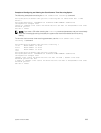
Configuring Tunnel source anylocal Decapsulation
The tunnel source anylocal command allows a multipoint receive-only tunnel to decapsulate
tunnel packets addressed to any IPv4 or IPv6 (depending on the tunnel mode) address configured on the
switch that is operationally UP.
The source anylocal parameters can be used for packet decapsulation instead of the ip address or
interface (tunnel allow-remote command), but only on multipoint receive-only mode tunnels.
The following sample configuration shows how to use the tunnel source anylocal command.
Dell(conf)#interface tunnel 1
Dell(conf-if-tu-1)#ipv6 address 1abd::1/64
Dell(conf-if-tu-1)#ip address 1.1.1.1/24
Dell(conf-if-tu-1)#
tunnel source anylocal
Dell(conf-if-tu-1)#tunnel mode ipip decapsulate-any
Dell(conf-if-tu-1)#tunnel allow-remote 40.1.1.2
Dell(conf-if-tu-1)#no shutdown
Dell(conf-if-tu-1)#show config
!
interface Tunnel 1
ip address 1.1.1.1/24
ipv6 address 1abd::1/64
tunnel source anylocal
tunnel allow-remote 40.1.1.2
tunnel mode ipip decapsulate-any
no shutdown
Multipoint Receive-Only Tunnels
A multipoint receive-only IP tunnel decapsulates packets from remote end-points and never forwards
packets on the tunnel. You can configure an additional level of security on a receive-only IP tunnel by
specifying a valid prefix or range of remote peers.
The operational status of a multipoint receive-only tunnel interface always remains up. Packets from the
remote addresses configured for a multipoint receive-only tunnel are decapsulated and are not marked
for neighbor resolution as for a standard tunnel’s destination address. Connected routes for the tunnel
interface’s IP subnet do not point towards the tunnel but towards the switch CPU for the receive-only
tunnel. The tunnel interface can function as an unnumbered interface with no IPv4/IPv6 address
assigned.
Guidelines for Configuring Multipoint Receive-Only Tunnels
• You can configure up to eight remote end-points for a multipoint receive-only tunnel. The maximum
number of remote end-points supported for all multipoint receive-only tunnels on the switch
depends on the hardware table size to setup termination.
• The IP MTU configured on the physical interface determines how multiple nested encapsulated
packets are handled in a multipoint receive-only tunnel.
• Control-plane packets received on a multipoint receive-only tunnel are destined to the local IP
address and routed to the CPU after decapsulation. A response to these packets from the switch is
only possible if the route to the sender does not pass through a receive-only tunnel.
• Multipathing over more than one VLAN interface is not supported on packets routed through the
tunnel interface.
Tunneling
899


















